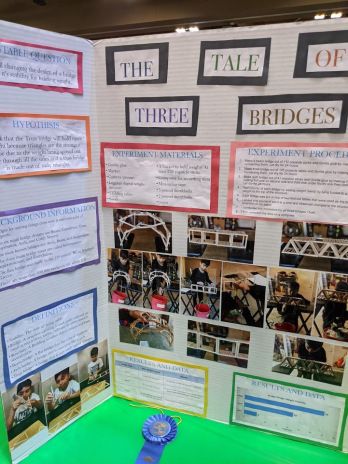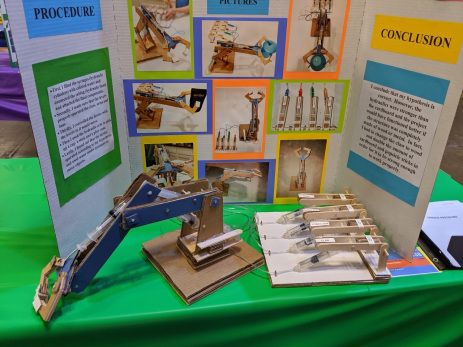
程序员。 博客镜像:https://kevinhu.me
Experience the Student Tech Festival in America
Recently, out of curiosity, I participated in the Austin Municipal Technology Festival as a volunteer. The whole event has four days. I only attended two days: one day in the jury area to assist in sending and receiving scorecards, one day assisting in the awards ceremony, and through this event, I experienced the atmosphere of the technology festival up close.
The conference is hosted by Austin Energy with funding from companies such as Dell. I visually estimated that there were several thousand students in the primary school group and the middle school group each, and the total number of students participating in the four-day conference should be around 10,000. In addition to the organizers, the judges are basically from practitioners of various professions in the society, some are working and many have retired, and they all participate as volunteers. According to my estimate, there are about 200 volunteer judges in a day, and many judges participate in different groups of judges, so there should be several hundred judges in total. There are about dozens of ordinary volunteers like me every day. It can be seen that the general public supports the conference.
Student participants were divided into secondary and primary groups. Each group will have one or several students present a project they have done under the leadership of their parents and mentors, and students will do major research or development on their own. For each professional project, a group of volunteer judges will interview students at the venue, give individual scores, and discuss with other judges in the group to arrive at the final ranking. As a volunteer, I had the opportunity to observe the performance of the students in detail - the wide range of topics in the students' projects, the strong hands-on ability shown by the projects, the students' writing ability, scientific literacy, and even the strong mathematics and programming skills impressed me. Shocked.

Projects in the primary school group usually require simpler abilities, and are generally used as science popularization and experimentation to cultivate interest. But children's imagination is very powerful, the content of the project is more life-like, and many are more cute: for example, whether the apple will turn yellow more slowly when dripped with lemon juice, whether the water you drink is acidic or alkaline, your cat How clean is it, the diaper absorbency test, and a few small crafting projects: making a hydraulic robotic arm out of cardboard and a syringe, studying the load-bearing capacity of cardboard bridges of different structures, and more, and some cute social science experiments: coming of age Can a person pass the 6th grade test, etc.


The project results of the group are the most amazing to me: the project directions include environment, robotics, biology, machinery, electronics, software, physics, mathematics, social science, behavior, and other professional directions. Many students demonstrate amazing scientific literacy, learning ability, and hands-on ability.
I have withheld the names of all students in the presentations for privacy.
For example, the junior high school group has a lot of electronic system design projects: designing a smart garage door, designing a wearable campus bully alert system, and so on. The hardware design of this alarm system includes a Raspberry Pi function board, and sensors such as a microphone and an acceleration detector. Students train Bully's voice on the computer, load the training parameters to the Raspberry Pi, and send a text message to alarm when the detected sound matches the training. The project presentation includes the students' descriptions of the school bullying news to explain the project approval. It also includes the overall project design block diagram, training process, hardware parameters, experimental analysis data results, and more. To be able to complete a complete project report from project initiation, hands-on experiments, finished products, and analysis under the guidance of such a young age, I think it is already very remarkable. This is a quality that is difficult for many college students in China to have.


The presentation of the high school group is more mature. They need to submit an abstract of the project, with a longer and more complete project process, research content, research methodology, and more in-depth analysis. I feel that the complexity of many projects is no less than that of college students' big assignments or even graduation projects. Such as analyzing the properties of proteins through programs and data, and so on. I had a chat with a high school student who attended the conference. He told me that his father was an engineer and that the project he was working on under his father's direction took an entire summer to complete.


On the official website of the event I found more summaries of student projects. It can be seen that many projects should be students participating in real research in university laboratories during high school.
Below I have selected summaries of several middle school group projects, possibly from high school or middle school students:
Catalase concentration in plant tissue after germination
Catalase Concentration of Plant Tissue After Germination
The purpose of this project is to learn how catalase concentration can be affected by different environmental conditions in different parts of a green onion plant. We tested the different concentrations of catalase in the roots and shoots by taking green onion juice soaked filters and putting them in H2O2. When catalase breaks down H2O2 it makes oxygen, which pushes the disc to the surface. The faster the reaction, the more catalase there is. We then tested the green onion plant in different light settings, minimal and high exposure. After testing and calculations, we discovered that there was more catalase in the roots than the shoots in the control and growth light scenarios. Then we compared all the root(light, dark, and control) data to find if the different amounts of light exposure affected the green onion plant's root average catalase concentration. The root's data difference was significant while the shoots were not, meaning we reject both null hypotheses.
The project studied the concentration of catalase in different parts of onions after germination under different conditions. The higher the concentration of catalase, the faster it will decompose the hydrogen peroxide solution, allowing the concentration to be measured from this point.
Lead removal from water using Moringa Oleifera as a natural biocoagulant
Using Morinag Oleifera as a Natural Bio Coagulant to Remove Lead from Water
Lead poisoning is a huge global problem effecting over 2 million people, and causes many health effects such as birth defects, coma, mental retardation, and even death. During a trip to India it was observed that villagers added a white powder to their water, and was later discovered that this substance was crushed moringa seeds. Moringa seeds have a positively charged cationic protein (natural coagultaor) in the seed kernel. The goal of this experiment was to find out if the moringa oleifera protein could coagulate and remove lead from water .Because lead nitrate and sodium hydroxide are ionic compounds, therefore undergoing double replacement reactions, it was concluded that the mass of the precipitate formed would be the mass of the lead present in the water. The lead concentrate used was 10^6 times the amount of lead that is deadly to the human body. After various chemical equations, it was determined that the mass of 10 mL .1 M lead was .2412 g. The average mass of lead content pres ent in water with 1 seed was .1798 g. This indicates that 1 moringa seed removed almost half of the lead present in the water. As moringa was added, the amount of lead decreased till there was only an average .0386 g of lead left in the water. This data can conclude that moringa removed almost all traces of lead present in the water. This groundbreaking data could potentially save millions of lives, and solve a huge world crisis.
This project investigated the effect of Moringa Oleifera seeds on lead removal from water. The students learned that many villagers in India use Moringa oleifera powder into domestic water. His research is whether moringa protein can effectively remove lead from water. Experiments show that the effect is very good.
Statistical analysis of causes, consequences and effective strategies for reducing emergency department overcrowding and overuse
Statistical Meta-Analysis of the Causes, Consequences, and Effective Strategies to Reduce Emergency Department (ED) Overcrowding and Overuse
Hospital emergency departments serve as an essential component for the provision of immediate medical care, but a large proportion of visits has been reported for non-urgent conditions. Overtime, unnecessary frequent visits, along with several other factors, can result in ED overcrowding. , the overall purpose of the study is to identify and evaluate effective methods that should be implemented to reduce emergency department overuse/overcrowding and improve clinical outcomes among patients. Approximately 300 relevant statistical studies and peer-reviewed journals associated with ED overcrowding were identified from major databases, including PubMed, CINAHL, Scopus, and NCHS. Other medical search engines were also used to meet additional objectives and fill in any gaps that were required in the study. Out of the 286 peer-reviewed articles that were categorized, 29 were selected for further statistical examination due to method similarities, explicit data results, and full fulfi llment of the objectives. Data extracted from the 29 studies included method design, sample size, population and setting, whether consequences affected staff and/or patients, primary causes, and effective strategies to counter emergency department overcrowding. Quantitative data, such as approximate emergency wait time and patient care time, from these selected sources were then analyzed, combined, and computed into statistical models and charts through the use of Microsoft Excel and RevMan 5 Software. Measures of central tendency and variability, forest and funnel plots, and regression graphs were created. In conclusion, emergency departments within the US do require additional improvements to their environmental settings and management strategies, such as through individualized care plans.
This project studies the misuse of emergency rooms in the United States, leading to overcrowding and underutilization of resources. Students searched for data in approximately 300 articles and analyzed data in 29 of them using software such as Excel and RevMan.
Yes, that's right, these are projects for middle school students.
I think I can get a glimpse of the leopard from these projects and experience the characteristics of American middle school science and technology education: many projects are not very complicated, nor do they have very difficult theoretical requirements such as mathematics, programming, etc., but require students to have enough interest in a field To understand, delve into and get hands-on with, and complete high-quality reports and presentations.
This kind of science and technology education brings students the core parts of scientific research: not theoretical knowledge or examination level, but a vision to find and discover problems, strong curiosity about problems, learning ability, and finding solutions to problems Method of hands-on ability, and good scientific expression and communication skills. Let students be able to stimulate interest during middle school, guide students to pay attention to the intersection of technology and social issues, and get good exercise.
In addition, all sectors of the American society have given great support and attention to this conference, and a large number of experienced people in the technology circles from all walks of life have volunteered to participate in this event. It can be seen that the United States attaches great importance to and strives to promote the education of popular science and scientific and technological progress.
Such a large-scale scientific and technological event may be difficult to imitate in the environment of domestic examination-oriented education. However, through continuous observation and reflection, I hope that the domestic science and technology education can gradually come out of the concept of focusing on examinations, so that students can experience the charm of science and technology more closely.
Like my work?
Don't forget to support or like, so I know you are with me..
Comment…